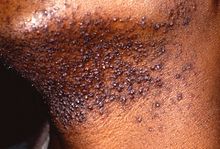Irritant folliculitis
| Irritant folliculitis | |
|---|---|
 | |
| Pseudofolliculitis barbae: a type of irritant folliculitis | |
| Specialty | Dermatology |
| Symptoms | Small red bumps in skin[1][2] |
| Usual onset | Any age[1] |
| Types | Pseudofolliculitis barbae[2] |
| Causes | Occlusion, friction, hair removal, application of some medications, contact with irritant chemicals[1][2] |
| Risk factors | Obesity[1] |
| Diagnostic method | Visualisation, history, negative microbiological culture[3] |
| Treatment | Avoid trigger, tetracycline[1] |
Irritant folliculitis is an inflammation of the hair follicle.[1] It characteristically presents with small red bumps in the skin at sites of occlusion, pressure, friction, or hair removal; typically around the beard area in males, pubic area and lower legs of females, or generally the inner thighs and bottom.[1][3] An associated itch may or may not be present.[1][2] Pseudofolliculitis barbae is a type of irritant folliculitis in the beard area.[2]
Mechanical factors that typically trigger irritant folliculitis include hair removal by razor, waxing, electrolysis, and by plucking.[2] Repeated rubbing of skin such as friction on the inner thighs, may result in the irritation.[3] Sunlight, and prolonged pressure such as sitting on one's bottom for long periods of time, may also trigger irritant folliculitis.[3] Irritant folliculitis may occur following the use of some medications or contact with irritant chemicals such as cutting fluids and coal tar.[3] Tight hair styles may cause irritant folliculitis on the scalp.[4] Other factors that increase chances of skin friction and moisture include obesity.[1]
Diagnosis is generally by history and visualisation of the rash.[3] The condition is not due to infection and swabs of the spots are typically negative.[5] It may appear similar to acne and other types of infectious folliculitis.[6]
Treatment considers removing the triggering factor, particularly to stop shaving.[6] Prolonged use of the antibiotic doxycycline may be an option.[1] If shaving is necessary, the condition may be prevented by avoiding soap and applying a generous amount of shaving gel.[2] Rubbing may be reduced by using powders.[1]
Any age may be affected.[1] It is common on the lower legs of women who shave there.[2]
Definition and types[edit]
Irritant folliculitis is a type of folliculitis, an inflammation of the hair follicle, not caused by infection.[3] Types include pseudofolliculitis barbae and perioral dermatitis.[3][2]
Signs and symptoms[edit]
The condition characteristically presents with small red bumps in the skin at sites of occlusion, pressure, friction, or hair removal; typically around the beard area in males, pubic area and lower legs of females, or generally the inner thighs and bottom.[1][3] An associated itch may or may not be present.[1][2]
Cause[edit]
Mechanical factors that typically trigger irritant folliculitis include hair removal by razor, waxing, electrolysis, and by plucking.[2] Other triggers may include sunlight, prolonged pressure such as sitting on one's bottom for long periods of time, and contact with chemicals such as cutting fluids and coal tar.[1][3] Lithium, halogens, corticosteroids, ACTH, isoniazid, phenytoin and some TNF-alpha inhibitors may cause irritant folliculitis.[3] Perioral dermatitis typically occurs following prolonged use of topical corticosteroid to face.[2] Tight hair styles may cause irritant folliculitis on the scalp.[4] Thick greasy moisturisers may trigger the condition.[2] Other factors that increase chances of skin friction and moisture include obesity.[1]
Diagnosis[edit]
Diagnosis is by history and visualisation of the rash.[3] A swab for culture does not grow bacteria or fungi.[2]
Differential diagnosis[edit]
Pseudofolliculitis barbae may be distinguished from infectious causes folliculitis of the beard area by the absence of fever and lymphadenopathy and the tendency to be more diffuse than localised.[7]
Treatment[edit]
Treatment involves removing the triggering factor, particularly shaving.[3] Sometimes doxycycline works as an anti-inflammatory medication.[1] Ceasing to shave for several months may help.[2] If shaving is necessary, the condition may be prevented by avoiding soap and applying a generous amount of shaving gel after a few months of stopping shaving and letting the skin settle.[2] Rubbing may be reduced by using powders.[1]
Epidemiology[edit]
Any age may be affected.[1] It is common on the lower legs of women who shave there.[2]
See also[edit]
References[edit]
- ^ a b c d e f g h i j k l m n o p q r s Edwards, Libby; Lynch, Peter J. (2022). Genital Dermatology Manual (4th ed.). Lippincott Williams & Wilkins. p. 899. ISBN 978-1-9751-6147-7.
- ^ a b c d e f g h i j k l m n o p q "Folliculitis". dermnetnz.org. Retrieved 10 July 2023.
- ^ a b c d e f g h i j k l m de Moll, Helen H.; Phelps, Robert G. (2022). "86. Folliculitis". In Lebwohl, Mark G.; Heymann, Warren R.; Coulson, Ian H.; Murrell, Dedee F. (eds.). Treatment of Skin Disease (6th ed.). Elsevier. p. 291. ISBN 978-0-7020-8210-8.
- ^ a b Agbai, Oma N.; Raffi, Jodi (2021). "11. Hair loss in women of color". In Li, Becky S.; Maibach, Howard I. (eds.). Ethnic Skin and Hair and Other Cultural Considerations. Switzerland: Springer. p. 152. ISBN 978-3-030-64829-9.
- ^ Ferri, Fred F. (2024). "Folliculitis". Ferri's Clinical Advisor 2024. Elsevier. p. 584. ISBN 978-0-323-75577-1.
- ^ a b Bolognia, Jean L.; Schaffer, Julie V.; Duncan, Karynne O.; Ko, Christine (2021). "31. Folliculitis". Dermatology Essentials (2nd ed.). Elsevier. p. 283. ISBN 978-0-323-70971-2.
- ^ Kuruvella, Trinath; Pandey, Shivlal (2023). "Tinea Barbae". StatPearls. StatPearls Publishing.
